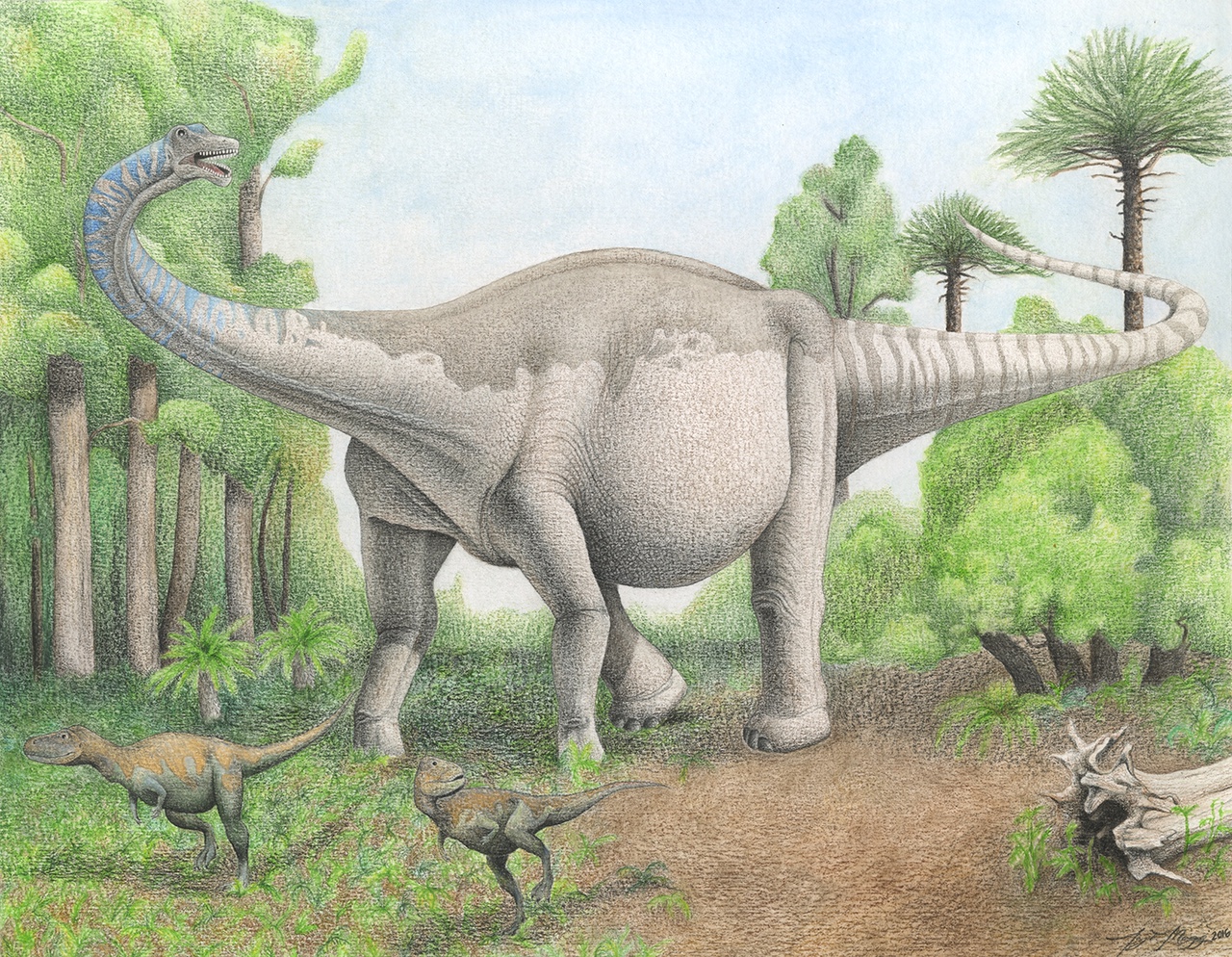Researchers have discovered a gigantic new species of dinosaur that is among the largest yet known to science. Named Notocolossus gonzalezparejasi, the new creature provides key information about the hind foot of giant titanosaurs, which are widely regarded as the most massive land animals that have ever existed. Notocolossus was described from fossil bones belonging to the back, tail, forelimb, and pelvis, plus a complete ankle and foot. The paper describing the discovery appears today in Scientific Reports, a freely-accessible journal from the publishers of Nature.
The two described fossil skeletons of Notocolossus were unearthed in southern Mendoza Province, Argentina, from rocks laid down late in the Cretaceous Period, roughly 86 million years ago. Both specimens were discovered by the study leader and project director, Argentine paleontologist Dr. Bernardo González Riga of CONICET (the Consejo Nacional de Investigaciones Científicas y Técnicas), IANIGLA, and the Laboratorio de Dinosaurios of the Facultad de Ciencias Exactas y Naturales of the Universidad Nacional de Cuyo (UNCUYO) in Mendoza Province. Other members of the research team include Dr. Matt Lamanna of Carnegie Museum of Natural History in Pittsburgh, USA, and three other Argentine paleontologists: Leonardo Ortiz David and Juan Pedro Coria of CONICET-IANIGLA and the UNCUYO Laboratorio de Dinosaurios and Dr. Jorge Calvo of the Centro Paleontológico Lago Barreales of the Universidad Nacional del Comahue in Neuquén Province.
According to Dr. González Riga, “Giant titanosaurs were the heaviest terrestrial creatures that ever lived. But the hind feet of these dinosaurs—which are critical for understanding how they stood and moved—were not completely known until now. Now we have new evidence that helps to solve this mystery.”
Titanosaurs are an important but puzzling group of dinosaurs. They are a type of sauropod, the huge, long-necked, long-tailed plant-eaters that many people think of when they hear the word “dinosaur.” Comprising more than 60 named species, titanosaurs lived on every continent and ranged in size from the weight of a cow to at least the weight of the heaviest humpback whales. They were the most common large herbivores in the Gondwanan (i.e., Southern Hemisphere) continents during the Cretaceous Period, the third and final time period of the Mesozoic Era, or Age of Dinosaurs. Despite their extraordinary species richness and diversity in body size, many aspects of titanosaur anatomy, evolution, behavior, and ecology are not well understood. This is due largely to the fact that most of these dinosaurs are known from woefully incomplete fossils, a situation that—with only a few exceptions, such as the still-unnamed species unveiled last week at New York’s American Museum of Natural History—is particularly pronounced in giant titanosaurs. Says Dr. Lamanna, “Most of the very biggest titanosaurs are known from just a few bones, which has made it really hard for paleontologists to learn much about them.”
Notocolossus is no exception in this regard; nevertheless, evidence suggests that it was among the largest titanosaurs, and therefore one of the heaviest land animals, yet discovered. Although the incompleteness of the skeleton of the new sauropod has prevented scientists from making precise estimates of its size, its humerus, or upper arm bone, is 1.76 m (5 ft 9 in) in length, which is longer than that of any other titanosaur for which this bone is known, including other giants such as Dreadnoughtus, Futalognkosaurus, and Paralititan. If, as is likely, the body proportions of Notocolossus were comparable to those of better preserved titanosaurs, the new beast was probably around 25–28 m (82–92 ft) in length and may have weighed between 40,000 and 60,000 kg (44–66 short tons, as much as roughly 9–13 zoo elephants put together). The gargantuan size and Argentinean location of the new titanosaur were the inspiration for its genus name, Notocolossus, which translates to “southern giant.” The species name is in honor of Jorge González Parejas, a Mendoza-based lawyer who has made significant contributions to the protection of that region’s paleontological heritage.
The enormous sizes attained by gigantic sauropods have generated a great deal of interest in the biology of these dinosaurs. Notocolossus is the first truly giant titanosaur for which the hind foot skeleton is known in its entirety. Interestingly, its foot shows anatomical peculiarities relative to those of other titanosaurs—such as an exceptionally short and robust, uniform construction—that may well be adaptations for supporting its extraordinary bulk. Moreover, the foot of the new creature contains a small number of bones, underscoring the fact that titanosaurs had the most reduced toes of all sauropods. Why these huge creatures apparently shrunk their toes remains a puzzle, but it stands in stark contrast to the evolutionary trend observed in another group of colossal land animals – the Proboscidea, which includes elephants and their close relatives. Rather than decreasing their number of toe bones, proboscideans actually increased the number of bones in their feet over the course of their evolution. The hind feet of elephants and sauropods show that these creatures evolved different skeletal strategies for support ing their massive bodies. “Now that we have the whole foot of a giant titanosaur, we can learn more about how these dinosaurs were able to carry more weight around than any other land animal in the history of life,” notes Dr. González Riga. “Argentina was truly the land of giants during the Cretaceous – and Notocolossus gives us new evidence on how these giants got so big.”

For more information, contact:
Universidad Nacional de Cuyo (Argentina)
Dr. Bernardo González Riga (first author and study leader)
CONICET, Laboratorio de Dinosaurios, Universidad Nacional de Cuyo, Mendoza, Argentina
bgonriga@yahoo.com.ar
bgonzalez@fcen.uncu.edu.ar
54-9-261-6376665 (mobile)
54-9-261-4325484 (office)
Prof. Damian Berridy
Secretario de Relaciones Institucionales y Comunicación, Facultad de Ciencias Exactas y Naturales, Universidad Nacional de Cuyo, Mendoza, Argentina
damianberridy@gmail.com
Carnegie Museum of Natural History (USA)
Dr. Matthew Lamanna (second author)
Section of Vertebrate Paleontology, Carnegie Museum of Natural History, Pittsburgh, Pennsylvania, USA
412-592-3361 (mobile)
412-578-2696 (office)
lamannam@carnegiemnh.org
Kathleen Bodenlos
Director of Marketing, Carnegie Museum of Natural History, Pittsburgh, Pennsylvania, USA
412-622-3361 (office)
bodenlosk@carnegiemnh.org
